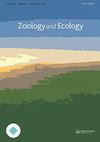Pseudomaquises in SW Bulgaria as a habitat for the ground beetles (Coleoptera: Carabidae)
Q4 Environmental Science
引用次数: 3
Abstract
A lack of sufficient data about ground beetles in maquis and maquis-like habitats in the whole Mediterranean region prompted this study. It brings new data to the knowledge of Carabidae species from Balkan pseudomaquis habitats in Bulgaria and reveals some patterns of species composition from zoogeographic and ecological points of view. Fieldwork was carried out in the period 5 April 2002 – 11 January 2004. A total of 305 specimens from 52 species were found, including two Balkan endemics and one Tertiary relict. These species belong to 23 genera and 12 tribes. Dromius quadrimaculatus (Linnaeus, 1758) and Harpalus fuscicornis Ménétriés, 1832 are new for the Bulgarian Struma Valley. Another 13 species are new for the Pirin Mountains. The richest tribe was Harpalini (21 species), followed by Carabini (6 species), Amarini and Sphodrini (5 species each). The most species-rich genus was Harpalus (13 species). Zoogeographical analysis showed that Euroasiatic and Mediterranean complexes were most prevalent. Xerothermic conditions in the habitats studied were also confirmed by the prevalence of the mesoxerophilous carabids. These habitats occur only locally in Bulgaria and support specific carabid assemblages. Knowledge about their diversity could be a keystone for the conservation of all target species living in these limited areas and encompassed by the adjacent Natura 2000 zones.保加利亚西南部为地面甲虫(鞘翅目:甲虫科)的栖息地
由于缺乏关于整个地中海地区猕猴和类猕猴栖息地的地面甲虫的足够数据,促使了这项研究。这一发现为保加利亚巴尔干假马蝇生境的卡拉贝科物种的认识提供了新的资料,并从动物地理学和生态学的角度揭示了一些物种组成模式。实地调查在2002年4月5日至2004年1月11日期间进行。共发现了来自52个物种的305个标本,包括两个巴尔干特有物种和一个第三纪遗留物。这些种隶属于12个部落23属。保加利亚斯特鲁玛谷发现的新发现有:四爪蛾(Linnaeus, 1758年)和镰刀蛾(Harpalus fuscicornis, 1832年)。另外13种是皮林山脉的新物种。最丰富的是Harpalini(21种),其次是Carabini(6种)、Amarini和Sphodrini(各5种)。种类最多的属是Harpalus(13种)。动物地理分析表明,欧亚和地中海复合体最为普遍。研究生境中的干热条件也被中嗜氧瓢虫的流行所证实。这些栖息地仅在保加利亚局部存在,并支持特定的carabid组合。了解它们的多样性可能是保护生活在这些有限地区的所有目标物种的基石,这些物种被相邻的Natura 2000保护区所包围。
本文章由计算机程序翻译,如有差异,请以英文原文为准。
求助全文
约1分钟内获得全文
求助全文
来源期刊

Zoology and Ecology
Agricultural and Biological Sciences-Animal Science and Zoology
CiteScore
1.00
自引率
0.00%
发文量
1
 求助内容:
求助内容: 应助结果提醒方式:
应助结果提醒方式:


